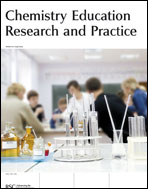Student test performances on behavior of gas particles and mismatch of teacher predictions
Abstract
The nature and behavior of gas particles are essential concepts in teaching and learning of school chemistry. However, findings about students' understanding of gas particles ⎯ their composition, structure, and interactions involving movement and distribution — revealed that the difficulties students encounter in understanding gas particles vary with age. The purpose of this article is to examine how students responded to six two-tier items in a diagnostic test about the behavior of gas particles in two containers and how teachers predicted students' test performance. The participants in this study were eighth graders (n = 102), ninth graders (n = 92), and physical science teachers (n = 31) in junior high schools in Taiwan. The results revealed that only a low percentage of students could answer the entire set of six questions correctly, and that the 9th graders outperformed the 8th graders. In addition, we found that students changed their models about gas behavior when the orientation of the apparatus changed, and that they had difficulty using a consistent model to answer all of the questions, especially those questions involving a change of pressure. The results also showed that the physical science teachers could not predict accurately the students’ understanding of the behavior of gas particles because they underestimated the effect of the pressure influencing students’ performance on test items. We conclude that the findings of this study suggested that science teachers could help students build a consistent view of gas particles by focusing on understanding why students would hold inconsistent models in different contexts. Educational implications for promoting students' and teachers' better use of models for learning and teaching the submicroscopic are discussed.
- This article is part of the themed collection: Diagnostic Assessment in Chemistry

 Please wait while we load your content...
Please wait while we load your content...